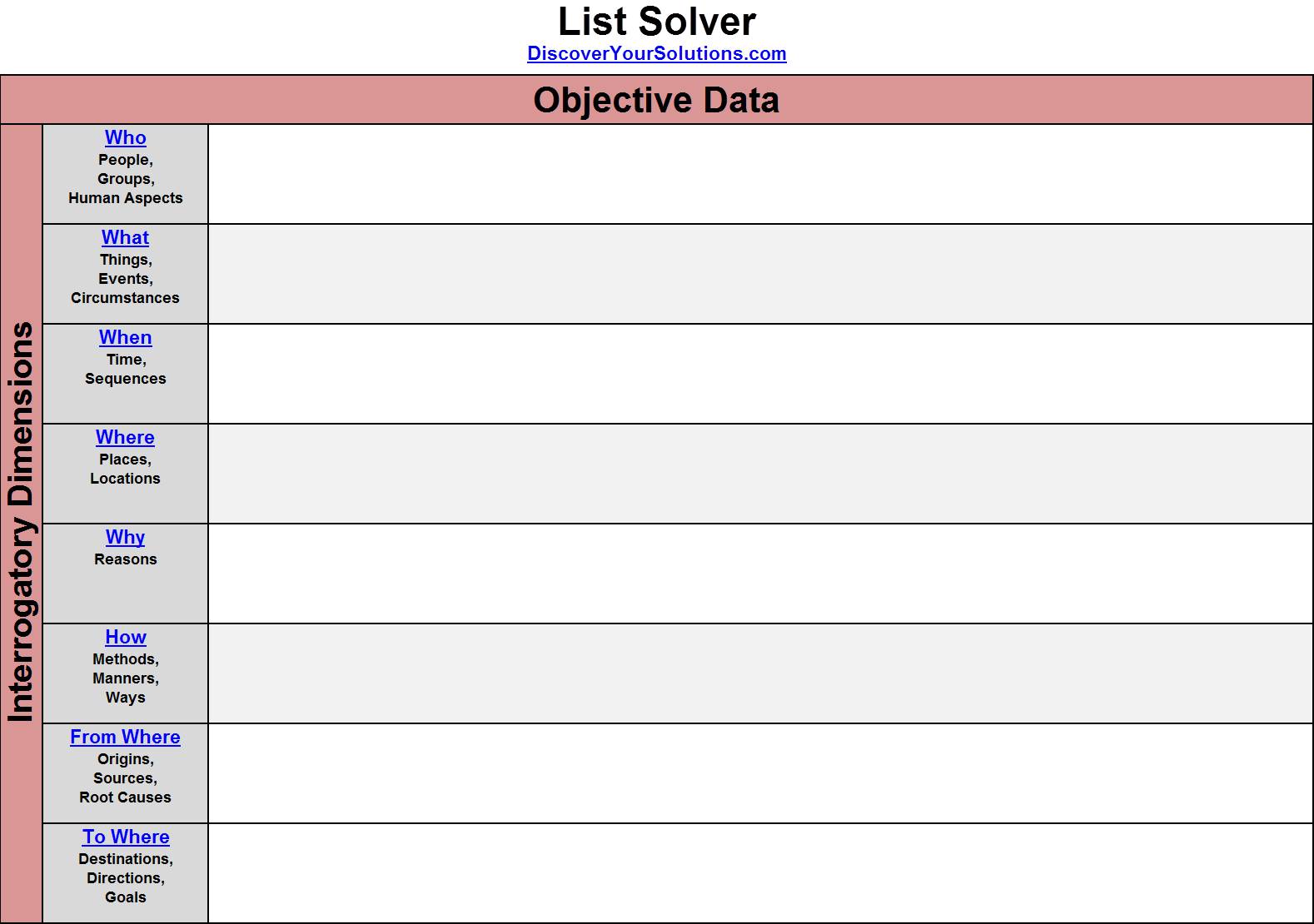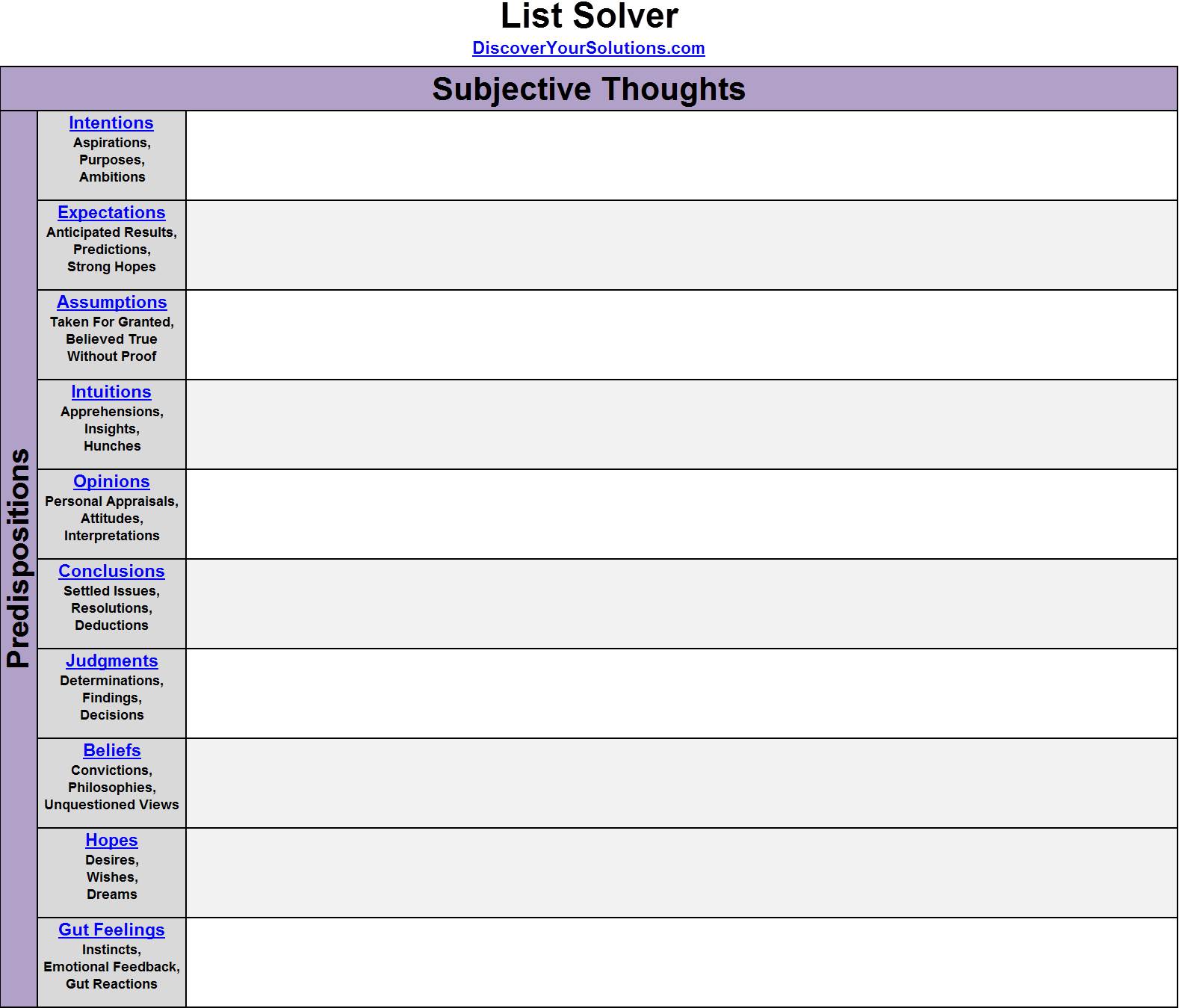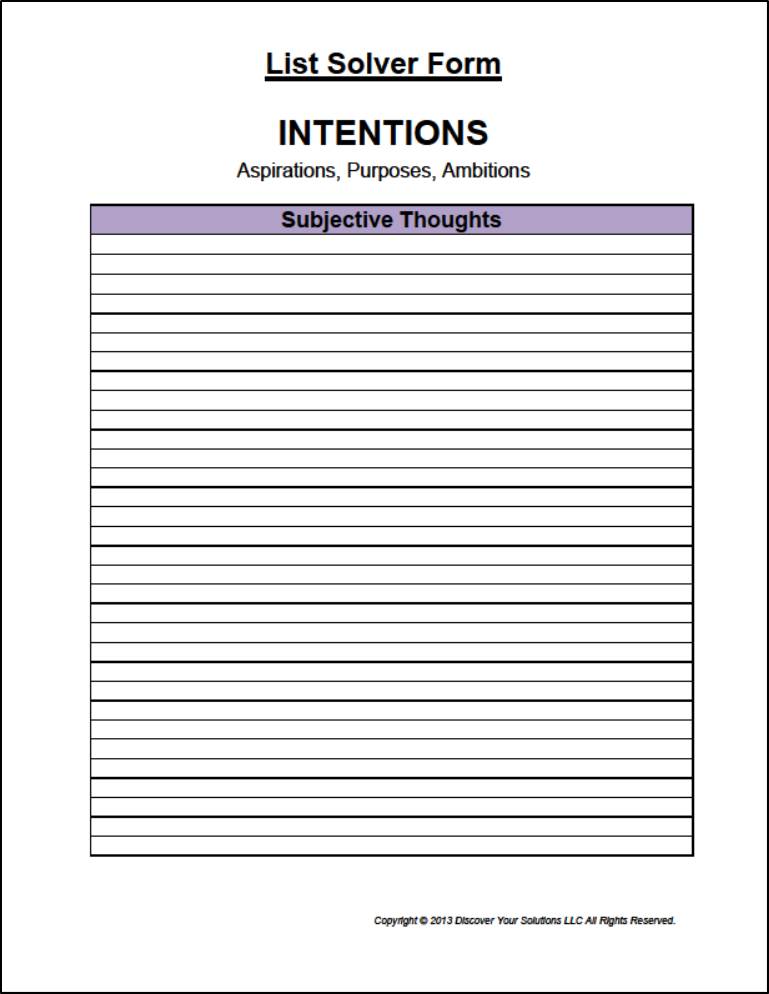List Solver
A simple solver for basic problems.
"Often, to understand your problem is to solve it." - Keith Glein
Goal: To get your data and thoughts organized, so you can create sensible solutions.
Your Objective Data
Step 1: Take a quick look the overview diagram below. It's a visualization of our List Solver for your Objective Data.

Word version of List Solver for Objective Data.docx (Click link to download Word version).
Excel version of List Solver for Objective Data.xlsx (Click link to download Excel version).
PDF version of List Solver for Objective Data.pdf (Click link to download PDF version).
Step 2: Download or Print our List Solver Forms. This is the form you'll working with. You can choose from our Word, Excel, or PDF versions below.

Word version of List Solver Form for Objective Data.docx (Click link to download Word version).
Excel version of List Solver Form for Objective Data.xlsx (Click link to download Excel version).
PDF version of List Solver Form for Objective Data.pdf (Click link to download PDF version).
Step 3: Gather together your information and get prepared to write down your objective data on the List Solver Forms. Your objective data includes your: Key Questions, Information (answers), Tasks, and Goals.
You'll be grouping them by: Who, What, When, Where, Why, How, From Where, and To Where.
Step 4: Start with your List Solver Form for 'Who'. Write down the 'Who' questions that you think are most important to understanding your problem.
If you need some help to come up with good 'Who' questions, go to Toolkit and see our Preliminary List of Standard 'Who' Questions.
Helpful Hint:
Don't get bogged down with answering each one of your Key Questions as they come to mind; just write them down. Once you've got all your Key Questions listed, you can go back and prioritize which ones need to be answered first. That being said, if a good quick answer comes up - definitely write it down.
Step 5: Write down any other Information that's related to your 'Who' questions (i.e. your answers). Remember, 'Who' questions have to do with the People, Groups, & Human Aspects related to your problem. Also, write down the Tasks and Goals you have for yourself, for other people, and for groups you've included in your analysis.
Step 6: Once you've completed your investigation of the Who aspects of your problem, repeat the process (in Steps 4 & 5) for What, When, Where, Why, How, From Where, and To Where.
Step 7: Review your Objective Data. Are there any gaps in your data?
Your Subjective Thoughts
Step 8: Next, you'll be examining your Subjective Thoughts. Take a quick look at the overview diagram below. It's a visualization of our List Solver for your Subjective Thoughts.

Word version of List Solver for Subjective Thoughts.docx (Click link to download Word version).
Excel version of List Solver for Subjective Thoughts.xlsx (Click link to download Excel version).
PDF version of List Solver for Subjective Thoughts.pdf (Click link to download PDF version).
Step 9: Download or print our List Solver Forms for your Subjective Thoughts (see Word, Excel, and PDF versions below):

Word version of List Solver Form for Subjective Thoughts.docx (Click link to download Word version).
Excel version of List Solver Form for Subjective Thoughts.xlsx (Click link to download Excel version).
PDF version of List Solver Form for Subjective Thoughts.pdf (Click link to download PDF version).
Step 10: Get prepared to write down your subjective thoughts on your List Solver Form. Your subjective thoughts are your personal thoughts that are closely related to your problem.
You'll be grouping them by: Intentions, Expectations, Assumptions, Intuitions, Opinions, Conclusions, Judgments, Beliefs, Hopes, and Gut Feelings.
Step 11: Start with your List Solver Forms for 'Intentions'. Write down your Intentions that you think are most important to your situation. If you need some help determining your Intentions, go to our Intentions tool in our Toolkit.
Helpful Hint:
If you can't quickly come up with your Intentions, just skip it and go to the next predisposition. Keep in mind that your focus should be on your personal thoughts that are at the heart of your problem. In-other-words, this exercise is more about quality than quantity.
Step 12: Write down any other information that's related to your 'Intentions'. Remember, your 'Intentions' have to do with your Aspirations, Purposes, & Ambitions.
Step 13: Once you've completed your examination of your Intentions related to your problem, repeat the process (in Steps 11 & 12) for your Expectations, Assumptions, Intuitions, Opinions, Conclusions, Judgments, Beliefs, Hopes, and Gut Feelings.
Step 14: Review your Subjective Thoughts.
Create Your Solutions
Step 15: Repeat Steps 1 thru 14 above for each one of your solutions.

Step 16: If you don't already have ideas for solutions, take a look at what's available in our Create Solutions section. We've dedicated this whole section of our Toolkit to help you generate solutions.
Step 17: To begin creating solutions, we recommend that you use our Hypothesis Generator tool.
Step 18: To create many potential solutions from a single plausible solution, try our Multiple Hypothesis Generator tool.
Step 19: If you can't find a suitable solution, it's time to take your analysis to the next level. Go to our Problem-Solving Matrix.
Key Points:
- Organize your data and thoughts using our List Solver Forms.
- Determine your key questions and find answers to them.
- Identify your tasks and goals.
- Examine your subjective thoughts (i.e. the thoughts you're predisposed to).
- Create solutions to your problem.
